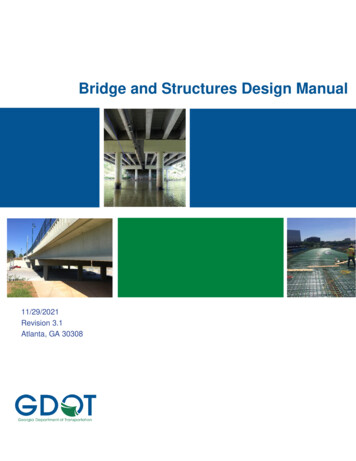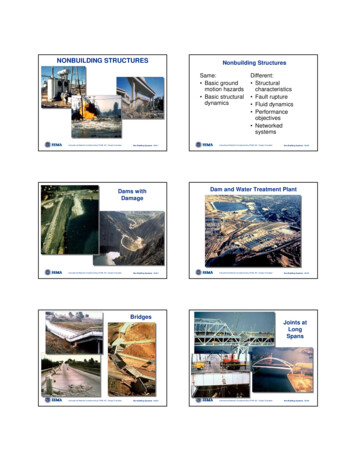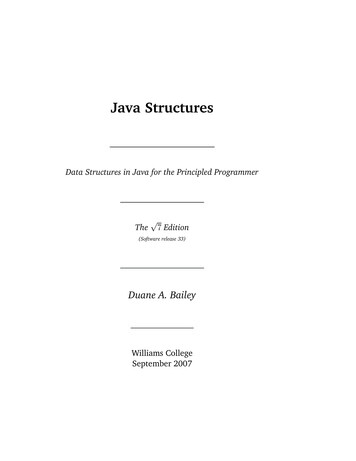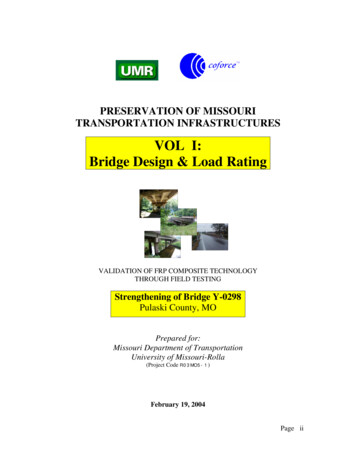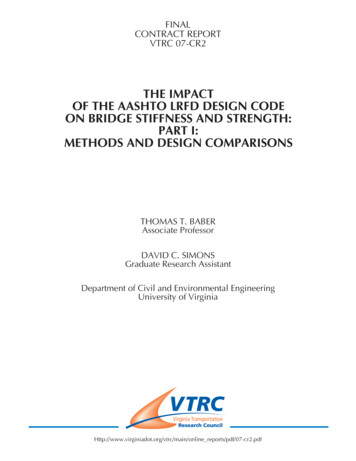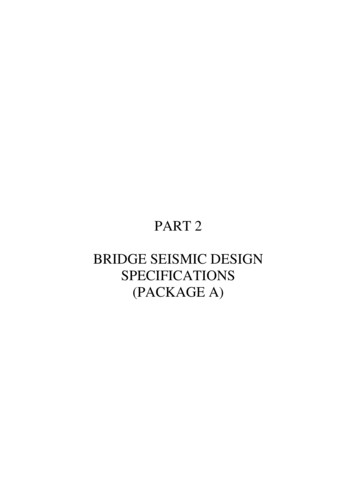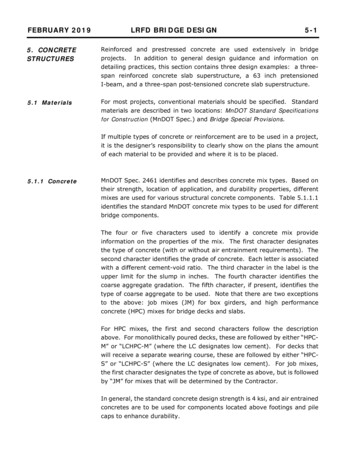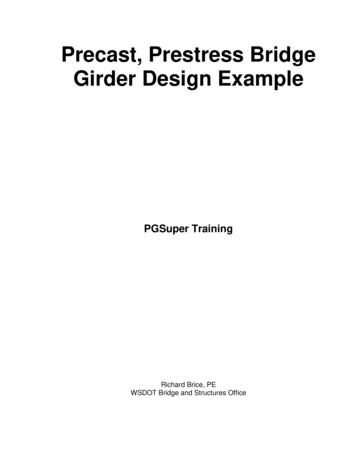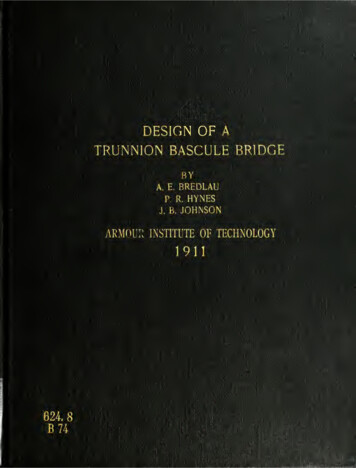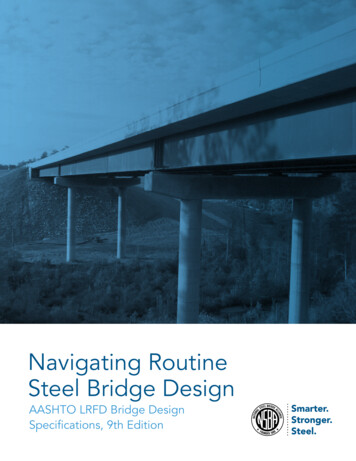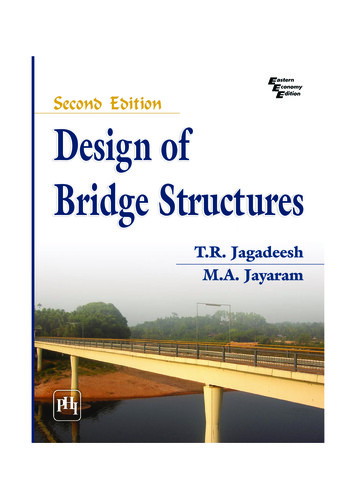
Transcription
Design of Bridge Structures
Design of Bridge StructuresT.R. JagadeeshPrincipalHMS Institute of TechnologyTumkurM.A. JayaramProfessorSiddaganga Institute of TechnologyTumkurNew Delhi-1100012009
DESIGN OF BRIDGE STRUCTURES, 2nd ed.T.R. Jagadeesh and M.A. Jayaram 2009 by PHI Learning Private Limited, New Deihi. Ail rights reserved. No part of this book maybe reproduced in any form, by mimeograph or any other means, without permission in writingfrom the publisher.ISBN-978-81-203-3852-4The export rights of this book are vested solely with the publisher.Seventh Printing (Second Edition).October, 2009Published by Asoke K. Ghosh, PHI Learning Private Limited, M-97, Connaught Circus,New Delhi-110001 and Printed by Jay Print Pack Private Limited, New Delhi-110015.
ContentsPrefacePreface to the First EditionxixiiiSection I — HYDRAULIC DESIGN1. Introduction1.11.21.33–7Importance of Hydraulic Factors in Bridge DesignComputation of Peak Flood Flow41.2.1 Empirical Methods41.2.2 Envelope Curves6Flood Flows and Catchment Scale72. Catchments2.12.22.338–35Small Catchments82.1.1 Characteristics82.1.2 Analysis of Runoff Response82.1.3 Runoff Concentration92.1.4 Concentration Time92.1.5 Application of the Rational Method2.1.6 Composite Catchments122.1.7 Types of Catchment Response14Midsize Catchments162.2.1 Characteristics162.2.2 Analysis of Runoff Response16Large Catchments252.3.1 Characteristics252.3.2 Frequency Analysis of Floods252.3.3 Gumbel Method33v10
vi Contents3. River Channels3.1 Determination of Peak Discharge363.1.1 Selection of Reach363.2 Hydraulic Geometry393.2.1 Sand Bed Channels403.2.2 Gravel Bed Channels403.2.3 Cohesive Bed Channels403.3 Effect of Bridge on River Regime413.4 Linear Waterways413.4.1 Streams with Rigid Boundaries413.4.2 Quasi-Alluvial Streams413.4.3 Alluvial Streams413.4.4 Sand Gravel and Cohesive Soil Beds3.5 Economic Span433.6 Afflux443.7 Scour463.7.1 Alluvial Streams463.7.2 Quasi-Alluvial Streams473.7.3 Alluvial and Quasi-Alluvial Streams3.7.4 Local ppendix: Computer Programs71–78References79–80Section II — STRUCTURAL DESIGN4. Design Loads for Bridges4.14.2Introduction83Design Loads834.2.1 Dead Load834.2.2 Vehicle Live Load834.2.3 Impact Effect874.2.4 Wind Loading884.2.5 Longitudinal Forces884.2.6 Centrifugal Forces894.2.7 Buoyancy894.2.8 Water Current Forces894.2.9 Thermal Forces904.2.10 Deformation and Horizontal Forces4.2.11 Erection Stresses914.2.12 Seismic Forces9183–9190
Contents5. Masonry Arch Bridges5.15.25.392–102Introduction92Design Details945.2.1 Rise of the Arch945.2.2 Radius of the Arch945.2.3 Thickness of the Arch Ring945.2.4 Depth of Haunch Filling94Dimensioning of Substructures955.3.1 Abutment955.3.2 Pier955.3.3 End Connectors95Design Problem1026. Pipe ion103Flow Patterns in Pipe Culverts104Culvert Alignment105Culvert Entrance Structures105Hydraulic Design of Pipe Culverts106Structural Design of Pipe Culverts106Classification of RCC Pipes108Reinforcement in Pipes108Design Problems1137. Slab Bridges7.17.27.37.4114–133Introduction114Wheel Load on Slabs114Effective Width Method1157.3.1 Slab Supported on Two Edges (Simply Supported Slabs)7.3.2 Cantilever Slabs117Dispersion Length117Design Problems134–149Introduction134Design Method135Design Problems1499. Beam and Slab Bridges9.19.21151338. Box Culverts8.18.2 viiIntroduction150Design of Interior Panel of Slab150–187150
viii Contents9.39.49.59.69.7Pigeauds Method151Design of Longitudinal Girders159Guyon–Massonet Method1599.5.1 Calculation of Longitudinal MomentHendry–Jaegar Method161Courbon’s Theory162Design Problems16018710. Plate Girder Bridges188–20210.1 Introduction18810.2 Elements of a Plate Girder and Their Design18910.2.1 Web18910.2.2 Flanges19010.2.3 Intermediate Stiffeners19010.2.4 Vertical Stiffeners19010.2.5 End Bearing Stiffeners19110.2.6 Lateral Bracing for Plate Girders191Design Problems20211. Composite Bridges203–22011.1 Introduction20311.2 Composite Action20311.3 Shear Connectors20411.3.1 Design Requirements of Shear Connectors11.4 Composite or Transformed Section207Design Problem22012. Substructures221–23212.1 Abutments22112.1.l Stability Analysis of Abutments12.2 Piers22512.2.1 Loads on Piers22512.2.2 Analysis of Piers227Design Problem20522423213. Bridge Foundations13.1 Types of Foundations23313.1.1 Well Foundations23313.1.2 Open Well Foundations23413.1.3 Components of Well Foundations13.2 Design of Wells236233–243235
Contents13.3Pile Foundations23713.3.1 Group of Piles23713.3.2 Design of Piles238Design Problems24314. Bearings and Expansion Joints14.114.214.314.4 ixBearings24414.1.1 Forces on Bearings24414.1.2 Types of Bearings244Design of Unreinforced Elastomeric BearingsBasis for Selection of Bearings250Expansion Joints25514.4.1 Closed Joints255Design Problems244–25624825615. Prestressed Concrete Bridge oduction257Principles of Strands, Tendons and Bars262Anchorages263End Block264Steps for Designing a Post-tensioned Prestressed ConcreteDeck Slab26515.9 Design Example: Post-tensioned Prestressed ConcreteDeck Slab26615.10 Design Example: Post-tensioned PrestressedConcrete T-beam Bridge Deck273Design Problems28716. Artificial Intelligence in Bridge Engineering16.116.2Introduction288AI Research in Bridge Engineering29016.2.1 Decision to Commission29016.2.2 Design29116.2.3 Aesthetics29116.2.4 Analysis29216.2.5 Loads29216.2.6 Planning29216.2.7 Erection29216.2.8 Monitoring293288–305
Design Of Bridge Structures25%OFFPublisher : PHI LearningISBN : 9788120338524Author : JAGADEESH, T.R., JAYARAM, M. A.Type the URL : http://www.kopykitab.com/product/734 3Get this eBook
15.9 Design Example: Post-tensioned Prestressed Concrete Deck Slab 266 15.10 Design Example: Post-tensioned Prestressed Concrete T-beam Bridge Deck 273 Design Problems 287 16. Artificial Intelligence in Bridge Engineering 288–305 16.1 Introduction 288 16.2 AI Research in Bridge Engineering 290 16.2.1 Deci

